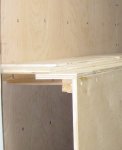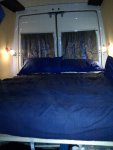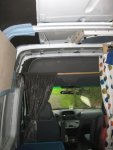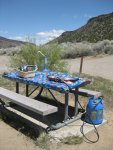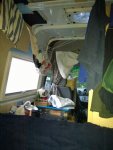At the suggestion of a couple of members, here is our Sprinter camper thread. Not sure where it best fits but it sort of started in response to the Thetford cassette thread, so I'll post it here for now. Warning - this is long and has lots of pics so I'll try posting in segments.
This is the first installment. We got our 2006 140" high roof cargo van in June 2009 and have been researching a long time so there is quite a lot to cover. We couldn't have done our conversion the way we did without this forum and the Sprinter Forum http://sprinter-source.com/forum/index.php so I want to eventually get as much up about what we figured out along the way as I can. Although our van isn’t a 4X4 and we aren’t going off-roading on purpose (well, maybe once in awhile) we did face a lot of the same decisions that other forum members have.
First, thinking through how the van will be used was key for us. Sounds obvious, but we wanted the van for two main reasons: to carry my husband's sculpture (see www.bradstory.com) and to go camping and on road trips. Since we started the conversion we have sold my husband's pickup truck so now we also need the van to be able to carry his bike (and sometimes mine), to carry firewood once every year or two when someone gives us wood too good to pass up, and to take trash barrels to the dump for ourselves and my husband's 93 year old Mom.
We wanted the camper aspect to be warm and comfy and friendly feeling and reasonably energy/cost -efficient. We chose the Sprinter for its space and also for its great fuel efficiency. We got 28 mpg on the Raven delivery trip. A bit less after adding all the weight of our camper conversion, but still over 25 mpg most of the time. We are in our early sixties and hope to have lots of trips in the next few years.
My husband built boats for 30 years before turning to sculpture so he has the wood-working skills and most of the common sense in our partnership. My role is do the detailed space planning, the research and buying and any tasks that don't need high-end carpentry skills. Neither of us have ever been interested in taking care of our own vehicles before so we are both learning how to do that now together.
The first key decision was how to make a comfortable bed that could be easily removed to carry other things. We thought about an Ikea bed and saw what Cedarsanctum did on the Sprinter Forum (thanks Jef!), went to Ikea and lay down on the slatted mattress support thingie they sell and decided to go that way. It flexes when you are lying on the bed so you don't get that unforgiving plywood platform ache but is firm enough for my bad lower back when combined with a mid-range Ikea foam mattress. The bed is really comfortable!
http://www.ikea.com/us/en/catalog/products/50160246
http://www.ikea.com/us/en/catalog/products/50139764
We decided that we wanted a permanent built-in cabinet on each side of the bed to hold up the Ikea slats and to serve as a narrow storage compartment for underwear, books, shoes, jackets, laundry, etc. - one side for each of us makes remembering where this stuff might be a little easier and it gives each of us a place to set down eyeglasses, a book, a drink, stuff we want at hand quickly when we get up. There is room enough on them for extra pillows too if they aren't needed at night. These little cabinets are only as wide as the wheel wells and have three small locker tops spread along their length for access. There is a lip to keep the slats from sliding much in either direction so they stay in place.
We like to read so we wanted good reading lights for the bed too. These came from Sailor Sam’s http://www.sailorsams.com/?gclid=CKrKxMCL1qUCFQWD5QodsWVgyQ
We like to look out the windows while in bed and have fresh air close by and really wanted some rear window visibility while driving so we put in two opening Peninsula Glass windows in the back doors. http://www.motionwindows.com/special-applications.php
This is the first installment. We got our 2006 140" high roof cargo van in June 2009 and have been researching a long time so there is quite a lot to cover. We couldn't have done our conversion the way we did without this forum and the Sprinter Forum http://sprinter-source.com/forum/index.php so I want to eventually get as much up about what we figured out along the way as I can. Although our van isn’t a 4X4 and we aren’t going off-roading on purpose (well, maybe once in awhile) we did face a lot of the same decisions that other forum members have.
First, thinking through how the van will be used was key for us. Sounds obvious, but we wanted the van for two main reasons: to carry my husband's sculpture (see www.bradstory.com) and to go camping and on road trips. Since we started the conversion we have sold my husband's pickup truck so now we also need the van to be able to carry his bike (and sometimes mine), to carry firewood once every year or two when someone gives us wood too good to pass up, and to take trash barrels to the dump for ourselves and my husband's 93 year old Mom.
We wanted the camper aspect to be warm and comfy and friendly feeling and reasonably energy/cost -efficient. We chose the Sprinter for its space and also for its great fuel efficiency. We got 28 mpg on the Raven delivery trip. A bit less after adding all the weight of our camper conversion, but still over 25 mpg most of the time. We are in our early sixties and hope to have lots of trips in the next few years.
My husband built boats for 30 years before turning to sculpture so he has the wood-working skills and most of the common sense in our partnership. My role is do the detailed space planning, the research and buying and any tasks that don't need high-end carpentry skills. Neither of us have ever been interested in taking care of our own vehicles before so we are both learning how to do that now together.
The first key decision was how to make a comfortable bed that could be easily removed to carry other things. We thought about an Ikea bed and saw what Cedarsanctum did on the Sprinter Forum (thanks Jef!), went to Ikea and lay down on the slatted mattress support thingie they sell and decided to go that way. It flexes when you are lying on the bed so you don't get that unforgiving plywood platform ache but is firm enough for my bad lower back when combined with a mid-range Ikea foam mattress. The bed is really comfortable!
http://www.ikea.com/us/en/catalog/products/50160246
http://www.ikea.com/us/en/catalog/products/50139764
We decided that we wanted a permanent built-in cabinet on each side of the bed to hold up the Ikea slats and to serve as a narrow storage compartment for underwear, books, shoes, jackets, laundry, etc. - one side for each of us makes remembering where this stuff might be a little easier and it gives each of us a place to set down eyeglasses, a book, a drink, stuff we want at hand quickly when we get up. There is room enough on them for extra pillows too if they aren't needed at night. These little cabinets are only as wide as the wheel wells and have three small locker tops spread along their length for access. There is a lip to keep the slats from sliding much in either direction so they stay in place.
We like to read so we wanted good reading lights for the bed too. These came from Sailor Sam’s http://www.sailorsams.com/?gclid=CKrKxMCL1qUCFQWD5QodsWVgyQ
We like to look out the windows while in bed and have fresh air close by and really wanted some rear window visibility while driving so we put in two opening Peninsula Glass windows in the back doors. http://www.motionwindows.com/special-applications.php




